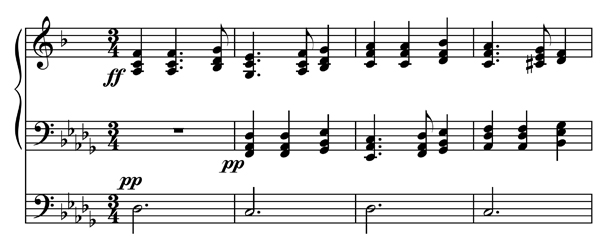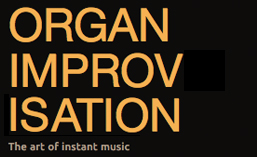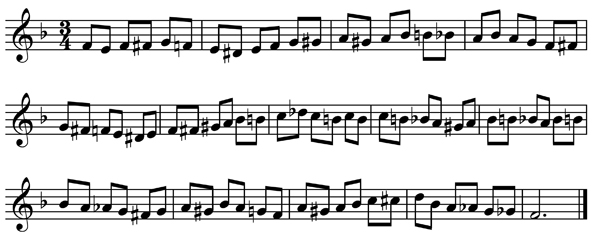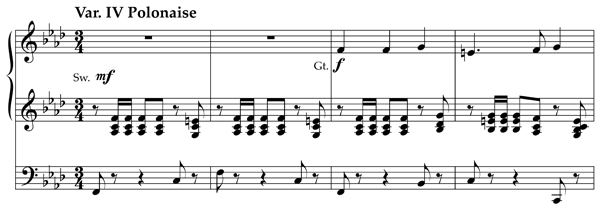First off, I must extend to you my apologies for not sending out a newsletter last week. I had started a draft but didn’t get to finish it before my schedule basically sent me off-line for a few days. Hopefully, the previous issues have given you plenty of ideas to work on so that you still had lots to practice!
Interludes
Today, I want to focus on the short phrase that appears between variations II and III of Ives’ Variations on ‘America.’ In my experience, many times it is during transitions and interludes that organists tend to wander and the coherence of the structure tends to break down. Knowing where you need to go and taking the shortest path to get there is something we could all spend some time working at. Ives is looking to move from F major to Db major, and since he is not afraid to combine two tonalities at once, he simply shifts the left hand and pedal into Db major while leaving the right hand in F major. It may not be a very pleasing sound to our ears (especially given the otherwise very tonal surroundings), but it certainly makes for a quick transition!
With these dissonant harmonies for the interlude, what does Ives give us to facilitate the transition? Thematic material, of course! Each hand harmonizes the melody in it’s proper key with the left hand making a canon with the right hand at the distance of one measure:

The consistent thematic material gives our ear an anchor even when the harmonic language is in flux. A convincing rhythm can go a long way towards enabling the listener to accept what the improviser creates. I have told many students that if the melody and rhythm are there, slips in the harmony may go unnoticed by the typical listener. Interludes and transitions are times to charge ahead with full confidence to the next destination, not times to wander aimlessly.
Canons
One of the steps towards improvising fugues is to learn to play canons. Though Ives only gives us a little snippet here, as we are studying the piece in order to find practice ideas, I can’t let this moment go by without encouraging you to practice making canons out of the themes that you study.
The easiest way to start is with the canon at the octave where the left hand follows the right hand. Depending upon the theme, the best distance may be a measure, half-measure, one beat, or even two measures. You should practice each of these playing all the way through the theme regardless of any parallels (fifths or octaves) that are created. When you are confident playing through the theme as it is in canon, begin to consider how you could alter the rhythm or melody in order to avoid any unwanted parallels or dissonances.
When you have mastered right hand leading with left hand following, be sure and try out all the other variations available at the organ:
- right hand leads, feet follow
- left hand leads, feet follow
- left hand leads, right hand follows
- feet lead, right hand follows
- feet lead, left hand follows
Depending upon the theme, you might even try a three part canon which would give you nine more options to try out (and we’re still at canon at the octave)!
Ives uses a canon at the minor sixth for his modulation interlude. Though canons most often are at the octave, fourth, or fifth, there is nothing to keep us from practicing them at any interval we wish. While the results may not be harmonically satisfying, I encourage you to try canons at all intervals. Keep the right hand in the tonic and shift the following voice (left hand or feet) through each of the twelve potential starting notes. If the starting note (for example, D) is in the tonic scale (F major), what happens to them theme if you use the tonic key signature (F major or D dorian) instead of the starting note key signature (D major)? What happens when the leading voice is in a different key with the following voice in the tonic? So many options to try!
Mental Gymnastics
Currently, I am preparing to run my first marathon. Anyone looking to accomplish a physical endurance task knows that you have to push your body outside it’s comfort zone if you are going to make progress towards the goal. Mental tasks require the same sort of stretching of our limits. Even if I only run a marathon once a year, training to do so, will make it easier for me to take the stairs at work, sprint across the street, or spend a day on my feet at a theme park. Likewise, practicing canons in assorted keys at different distances will give you more mental flexibility and confidence to tackle new improvisation tasks that will suddenly seem easy by comparison!
We readily acknowledge the need to practice physical technique (even scales and arpeggios). Improvisation requires not only physical skills, but mental aptitudes as well. I challenge you to challenge yourself and discover ways to move beyond your comfort zone. What can you do today to push your mental envelope?
Challenging you to find the next level,
Glenn
Recent additions to organimprovisation.com:
Organists:
Reviews:
Themes and Styles:
- Ein feste Burg
- In the Style of Mozart
- New Britain (Amazing Grace)
- Nun danket alle Gott
- O dass ich tausend Zungen hätte
- TV Show Themes
Newsletter Issue 14 – 2014 08 04
See the complete list of past newsletter issues here.
Sign up to receive future issues using the box to the right on this page.









